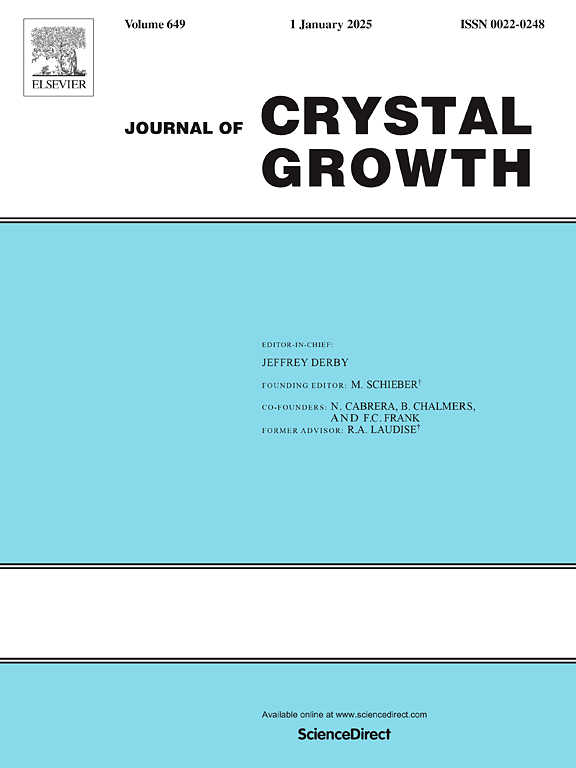Influence of urea on growth habit and Physicochemical properties of ammonium chloride single crystal
IF 2
4区 材料科学
Q3 CRYSTALLOGRAPHY
引用次数: 0
Abstract
The Ammonium chloride (NH4Cl) has dendritic growth habit. The dendritic growth habit of NH4Cl was suppressed in the presence of urea. The single crystals with uniform dimensions were harvested using solution growth method by the slow evaporation. The single crystal XRD analysis of urea added NH4Cl confirms the cubic crystal system and the lattice constant was found to be a = b = c = 3.877 Å and axial angle is α = β = γ = 90°. Purity of the grown crystal in the crystalline phase is shown by the powder XRD. No variation in cell parameter and crystal structure is observed from the results obtained from both single crystal and powder XRD. The presence of functional groups and vibration were confirmed using Fourier transform infrared spectroscopy. UV–Vis-NIR spectrum revealed the transparency of the grown crystal is 85 % and the obtained optical band gap energy of the grown crystal is 3.42 eV. The obtained SHG efficiency from the Kurtz and Perry powder technique is two times higher than KDP crystal. The broad emission from photoluminescence spectrum at 373 nm indicates that, the grown crystal possesses potential for the manufacture of light emitting diodes. The Thermal property of urea added with NH4Cl molecule shows eutectic melting point at 275 °C. The work hardening coefficient of the grown crystal obtained from microhardness analysis is 1.77. Dielectric behaviour and ac conductivity of urea added NH4Cl single crystal was studied for the different temperature and frequency and it’s lower activation energy was found that 0.00875 eV at applied frequency 1 kHz. The photoconductivity measurement verified that nature of the crystal was positive photoconductive.
尿素对氯化铵单晶生长习性及理化性质的影响
氯化铵(NH4Cl)具有枝晶生长习性。尿素的存在抑制了NH4Cl的枝晶生长习性。采用缓慢蒸发的溶液生长法获得尺寸均匀的单晶。加入NH4Cl的尿素的单晶XRD分析证实其为立方晶系,晶格常数为a = b = c = 3.877 Å,轴向角为α = β = γ = 90°。粉末XRD表征了晶相中生长晶体的纯度。从单晶和粉末XRD的结果来看,电池参数和晶体结构没有变化。利用傅里叶变换红外光谱证实了官能团的存在和振动。紫外-可见-近红外光谱显示,生长晶体的透明度为85%,获得的光学带隙能量为3.42 eV。采用Kurtz和Perry粉末技术获得的SHG效率比KDP晶体高2倍。在373 nm处的光致发光光谱显示出较宽的发射光谱,表明该晶体具有制造发光二极管的潜力。加入NH4Cl分子的尿素的热性能在275℃时表现为共晶熔点。显微硬度分析表明,生长晶的加工硬化系数为1.77。研究了不同温度和频率下尿素添加NH4Cl单晶的介电性能和交流电导率,发现在施加频率为1 kHz时,尿素添加NH4Cl单晶的活化能较低,为0.00875 eV。光导测量证实了晶体的性质为正光导。
本文章由计算机程序翻译,如有差异,请以英文原文为准。
求助全文
约1分钟内获得全文
求助全文
来源期刊

Journal of Crystal Growth
化学-晶体学
CiteScore
3.60
自引率
11.10%
发文量
373
审稿时长
65 days
期刊介绍:
The journal offers a common reference and publication source for workers engaged in research on the experimental and theoretical aspects of crystal growth and its applications, e.g. in devices. Experimental and theoretical contributions are published in the following fields: theory of nucleation and growth, molecular kinetics and transport phenomena, crystallization in viscous media such as polymers and glasses; crystal growth of metals, minerals, semiconductors, superconductors, magnetics, inorganic, organic and biological substances in bulk or as thin films; molecular beam epitaxy, chemical vapor deposition, growth of III-V and II-VI and other semiconductors; characterization of single crystals by physical and chemical methods; apparatus, instrumentation and techniques for crystal growth, and purification methods; multilayer heterostructures and their characterisation with an emphasis on crystal growth and epitaxial aspects of electronic materials. A special feature of the journal is the periodic inclusion of proceedings of symposia and conferences on relevant aspects of crystal growth.
 求助内容:
求助内容: 应助结果提醒方式:
应助结果提醒方式:


